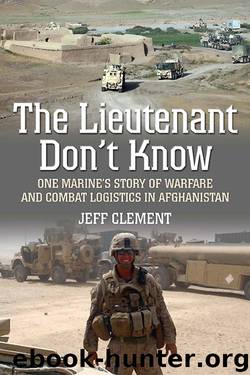The Lieutenant Don't Know: One Marine's Story of Warfare and Combat Logistics in Afghanistan by Clement Jeffrey

Author:Clement, Jeffrey
Language: eng
Format: epub
Publisher: Casemate Publishers & Book Distributors, LLC
Published: 2014-12-01T16:00:00+00:00
Poppy fields on the left (irrigated with several inches of water) and wheat fields on the right of this route limited the convoy’s mobility to a single route. Insurgents could easily target the convoy by emplacing an IED several hundred meters ahead of us on the route they knew we were stuck on.
We stayed in the open desert as long as possible, where the freedom to maneuver limited the risk of IEDs, but we had to cut through the compounds at some point. The Route Clearance Platoon entered the compounds around 1600. The route was narrow, with barely enough space between the mud walls to fit our trucks through. Almost immediately, the RCP determined they would have to clear the route dismounted. The three kilometers to get through would take something like 15 hours to clear. And we knew it going in. 15 hours of painful, step-by-step minesweeping.
IEDs were found almost immediately. The first one was big, with a high metallic signature. It seemed almost too easy that the IED was found that quickly, and the ease of that find just added to the stress. Were we supposed to find that piece of metal, so that while dealing with it, a hidden, more deadly IED would explode or an ambush would erupt?
The engineers began interrogating the suspected IED, and unearthed three 120mm Russian mortars strung together with det cord and a pressure plate. This was the most sophisticated IED that had been seen in the area in a long time, and also one of the most deadly. We were up against the insurgent varsity squad, and they weren’t messing around.
I had been awake for 38 hours by that time. The sun had begun to set, but there was nowhere to go. The convoy inched forward, moving only as fast as the soldiers up front could clear. Clearing with a metal detector is exhausting, especially while wearing body armor and under the intense stress of possibly being in a sniper’s crosshairs. The Route Clearance Platoon soon asked for our Marines to rotate in and take turns on the metal detectors. Though our Marines were not engineers, everyone was trained on how to use the metal detectors to search for IEDs, and the truck drivers of CLB-6 did what they had to do.
IEDs were found every few dozen meters. The convoy would inch forward, and then halt while the IEDs were “BIP’d,” deliberately exploded with C4 explosives. The sun was near the horizon.
The “evening transition period,” the most dangerous time for us, was approaching. There was too much light for our infrared NVGs to provide good contrast and a distinct advantage, but too little light for ideal vision with human eyes alone. The relatively short range and limited visibility through our truck windows limited the effectiveness of our PVS-14 NVGs anyway. In other words, all our technology was nullified, and during the evening transition period, we were reduced to an even playing field with the insurgents.
On that day, as on so many
Download
This site does not store any files on its server. We only index and link to content provided by other sites. Please contact the content providers to delete copyright contents if any and email us, we'll remove relevant links or contents immediately.
| Afghan & Iraq Wars | American Civil War |
| American Revolution | Vietnam War |
| World War I | World War II |
Waking Up in Heaven: A True Story of Brokenness, Heaven, and Life Again by McVea Crystal & Tresniowski Alex(37459)
Empire of the Sikhs by Patwant Singh(22736)
We're Going to Need More Wine by Gabrielle Union(18593)
Hans Sturm: A Soldier's Odyssey on the Eastern Front by Gordon Williamson(18306)
Leonardo da Vinci by Walter Isaacson(12749)
The Radium Girls by Kate Moore(11572)
Tools of Titans by Timothy Ferriss(7743)
Educated by Tara Westover(7638)
How to Be a Bawse: A Guide to Conquering Life by Lilly Singh(7137)
Permanent Record by Edward Snowden(5503)
The Last Black Unicorn by Tiffany Haddish(5389)
The Rise and Fall of Senator Joe McCarthy by James Cross Giblin(5131)
Promise Me, Dad by Joe Biden(4893)
The Wind in My Hair by Masih Alinejad(4811)
The Crown by Robert Lacey(4550)
A Higher Loyalty: Truth, Lies, and Leadership by James Comey(4524)
The Iron Duke by The Iron Duke(4091)
Joan of Arc by Mary Gordon(3758)
Stalin by Stephen Kotkin(3697)
